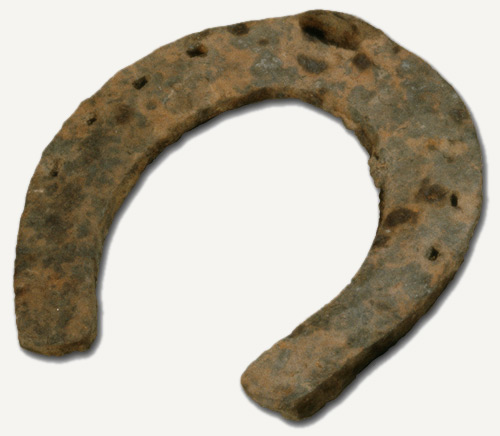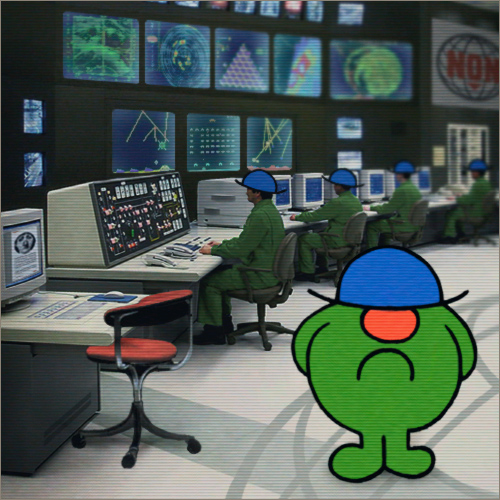“Throughout Germany the belief obtains that a horseshoe found on the road, and nailed on the threshold of a house with the points directed outward, is a mighty protection not only against hags and fiends, but also against fire and lightning; but, reversed, it brings misfortune. In eastern Pennsylvania, however, even in recent times, the horse-shoe is often placed with the prongs pointing inward, so that the luck may be spilled into the house. The horse-shoe retains its potency as a charm on the sea as well as on land, and it has long been a practice among sailors to nail this favorite amulet against the mast of a vessel, whether fishing-boat or large sea-going craft, as a protection against the Evil One.” - Robert Means Lawrence, M.D. from The Magic of the Horse-Shoe 1899.
“It’s good luck to find a horseshoe and bad luck to lose one. It is said that when a witch spies one nailed over a door, she must ride every road that the horseshoe has ever travelled; and by that time, it will be morning and her wicked powers will cease. Although this belief can be traced back to antiquity, it is credited in England to Saint Dunstan, the patron saint of goldsmiths.” - Michael Patrick Hearn from The Annotated Huck Finn 2001.
“Among the Romans there prevailed a custom of driving nails into cottage walls as an antidote against the plague. Both this practice and the later one of nailing up horse-shoes have been thought by some to originate from the rite of the Passover. The blood sprinkled upon the doorposts and lintel at the time of the great Jewish feast formed the chief points of an arch, and it may be that with this in mind people adopted the horse-shoe as an arch-shaped talisman, and it thus became generally emblematic of good luck.”
“If a horse be shod with shoes made from a sword wherewith a man has been slain, he will be most swift and fleet, and never, though never so hard rode, tire.” - Robert Means Lawrence, M.D. from The Magic of the Horse-Shoe 1899.

“In Henderson’s Folk-Lore of the Northern Countries of England, p. 187, mention is made of a remarkable method of treatment intended for the development of sickly, puny children who are thought to be under the influence of an evil spell which retards their growth, a notable instance of survival of the old belief in the blacksmith’s magical powers. Very early in the morning the little patient is brought to the shop of a smith of the seventh generation, if such can be found, and laid quite naked on the anvil. The blacksmith raises his hammer thrice as if to strike a glowing horse-shoe, each time letting it gently fall on the child’s body, –a simple ceremony, but vastly promotive of the child’s physical welfare, in the minds of its rustic parents.”
“The historian Diodorus Siculus said that the Chaldeans imagined the earth as having the shape of a round boat turned upside down. The boats still used on the rivers Tigris and Euphrates resemble in form a beehive with a considerable bulge in the middle. Gerald Massey (The Natural Genesis, vol. ii. p. 63) says that this conception of the earth’s figure corresponds to the Egyptian Put-sign with its hollow underneath. Various forms of this formation of the world are extant. The horse-shoe is one. Hence its value as a symbol of superstition. The head-dress of the Egyptian goddess Hathor has the shape of a horse-shoe. The letter omega is another form of the same sign.” - Robert Means Lawrence, M.D. from The Magic of the Horse-Shoe 1899.

“In some Roman Catholic countries the priests are wont to brand cows and pigs on the forehead with the mark of a horse-shoe, to insure them against disease. It was, moreover, an old Scotch superstition, or freet, to pass a horse-shoe thrice beneath the belly and over the back of a cow that was considered elf-shot.”
“We learn from Tacitus, moreover, that the Teutonic peoples used white horses, as the Romans used chickens, for purposes of augury, and divined future events from different intonations of neighings. Hence it probably is that the discovery of a horse-shoe is so universally thought lucky, some of the feelings that once attached to the aninial itself still surviving around the iron of its hoof. For horses, like dogs and birds, were universally accredited with a greater insight into futurity than man himself.”
“In the northernmost districts of Scotland exists a belief that if the first shoe put on the foot of a stallion be hung on the byre door, no harm will come near the cows; and in the same region, if a horse-shoe be placed between the houses of quarrelsome neighbors, neither incurs any risk of evil as a result of the other’s illwishes.” - Robert Means Lawrence, M.D. from The Magic of the Horse-Shoe 1899.

“The Germans have a saying in regard to a young girl who has been led astray, – “She has lost a horseshoe.” This saying has been associated with the shoe as a symbol of marriage, an idea found both in the northern and Indian mythologies. But the phrase has been also thought to refer to the horse-shoe shaped gloria which crowns the head of the Virgin, the horse-shoe thus becoming the symbol of maidenly chastity. Again, it has been suggested, in reference to the same phrase, that the horse-shoe is a symbol of the V (or first letter of the word Virgo), which is used in church records to designate the unmarried state, just as the word ‘spinster’ is used in legal documents.”
“The origin of the horse-shoe as a charm has been ascribed to its resemblance to the metallic aureole or meniscus formerly placed over the heads of images of patron saints in churches, and which is also represented in ancient pictures of the Virgin.” - Robert Means Lawrence, M.D. from The Magic of the Horse-Shoe 1899.

“The present belief in the lucky horseshoe is connected with the ancient emblems of the female genitals, the yoni. In olden times, the people were in the habit of making charcoal drawings of the female genitals over the doors of their houses to ward off ill luck. Now, the horseshoe has a great resemblance with the form of the vulva. From this symbol originates the horseshoes alleged power to ward off evil and to bring luck.” - Bernard S. Tamley Jr. from Love, A Treatise on the science of sex-attraction 1919.
“There is good reason to suppose that the crescent form of the horseshoe links the symbol to pagan Moon goddesses of ancient Europe such as Artemis and Diana, and that the protection invoked is that of the goddess herself, or, more particularly, of her sacred vulva. As such, the horseshoe is related to other magically protective doorway-goddesses, such as the Irish sheela-na-gig, and to lunar protectresses such as the Blessed Virgin Mary, who is often shown standing on a crescent moon and placed within a vulval mandorla or vesica pisces” -Cat Yronwode, from Luckymojo.com
-
Everyone can identify a horseshoe as a “lucky charm” (purple marshmallow incarnations included or not) but, as with so many cultural artifacts we drag the symbol through the ages with us, generation to generation, becoming less and less familiar with its origins, until we are almost totally divorced from whatever specific properties endowed it with power in the human imagination to begin with. Our modern cultures are positively littered with just such transmogrified items. From prevailing ideas to matters of “common sense” to everyday objects to sprawling institutions to the words we use to describe it all. We’ve had a direct hand in so very little of it and are so far removed from their origins… it’s almost frightening really, if you take a moment to think on it.
It strikes me though that in the case of the horseshoe it’s particularly pronounced and unfortunate. We’ve put ourselves in a position by which our luck, or the portion at least governed by horseshoes, can literally run out. I mean how likely are any of us to happen upon an actual horseshoe, one worn and ridden, which we might pick up and nail above our door? It might be said at this stage in the game that the luck of a horseshoe could be attributed, like that of a four leaf clover, to sheer rarity.

It’s entirely possible that the day may come when the horseshoe no longer exists at all as a functional object; when it will be produced, in the form of jewelry and bauble and talisman, as a symbol only. And what a paltry and impotent charm that would be eh?
Do you want witches running willy-nilly through your apartment at night? Or faeries or goblins? Or hags and fiends? I don’t. I’ve got enough to worry about, so I think it’s time we safeguard our luck. Why not take some direct action instead of letting generations of dead smithies and poets and historians and cult leaders dictate the auspices of our fortune? We only have so much of it after all, and probably too little as it is.
I’ve thought on it a bit and in attempting to land upon something which is functionally equivalent to the horseshoe but modern, which retains some of the symbolic character and is readily available, one solution presented itself which seemed just about perfect, and which I think reflects we moderns nicely–

Hey, the times they are a changin’, the march of progress, and all that.
Hope you enjoyed.
-
For more on horseshoes, as luck-safe or otherwise, see the following-
Horseshoes at Wikipedia.
Horse Shoes at The Medieval Technology Pages
The History of Horseshoes at About.com
The Magic of the Horse-Shoe at Sacred Texts or the downloadable full book pdf at Google books
The Horseshoe at Lucky Mojo
The Historical Development of the Horseshoe Scientifiv American Suppliment 1891, at Gutengerg.
The Significance of the Horseshoe at The Wild West
hide full text
































